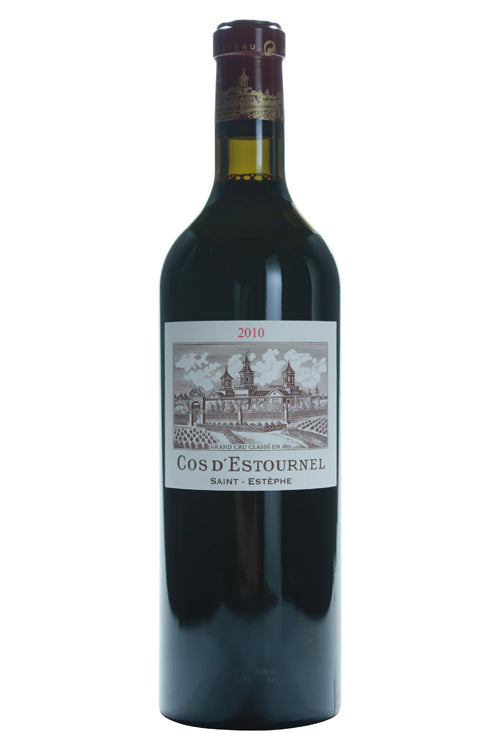1
/
of
1
Cos d'Estournel - 2010 (750ml)
Cos d'Estournel - 2010 (750ml)
Regular price
$349.99
Sale price
$349.99
Regular price
$419.99
Unit price
/
per
The 2010 is a more structured, restrained, less flamboyant version of the 2009. A final blend of 78% Cabernet Sauvignon, 19% Merlot and the rest Cabernet Franc and Petit Verdot that hit 14.5% natural alcohol, this wine (which represents only 55% of the estate's production) is full-bodied, classic and built along the lines of the 2000 (although that wine was made before Reybier acquired the estate and upgraded quality significantly). This wine exhibits beautifully pure notes of creme de cassis, blueberry liqueur, pen ink, graphite and hints of toast and vanillin. The wine is full and rich, and although aged in 80% new oak, the wood is a subtle background component. This beauty will take longer to round into shape than the dramatic and compelling 2009. Forget it for 5-8 years, and drink it over the following three-plus decades.
Robert Parker - 97+ points
Robert Parker - 97+ points
Availability:
4 In Stock
$25 Shipping on Orders +$299
Couldn't load pickup availability
Share :

- varietal
- Region
- Type
- Reviews
Product Review
The 2010 is a more structured, restrained, less flamboyant version of the 2009. A final blend of 78% Cabernet Sauvignon, 19% Merlot and the rest Cabernet Franc and Petit Verdot that hit 14.5% natural alcohol, this wine (which represents only 55% of the estate's production) is full-bodied, classic and built along the lines of the 2000 (although that wine was made before Reybier acquired the estate and upgraded quality significantly). This wine exhibits beautifully pure notes of creme de cassis, blueberry liqueur, pen ink, graphite and hints of toast and vanillin. The wine is full and rich, and although aged in 80% new oak, the wood is a subtle background component. This beauty will take longer to round into shape than the dramatic and compelling 2009. Forget it for 5-8 years, and drink it over the following three-plus decades.
Product Score
97
Cabernet Sauvignon is one of the most prominent dark-skinned grape varieties except Merlot in terms of area under vines, but which comprises our largest selection of wines. Grown in just about every wine producing region and climate, Cabernet Sauvignon can express a huge range of aromas, from green peppers in cool climates through to dark jammy fruit in hot regions. Common aromas include blackcurrants, mint, graphite, and forest floor, to name a few. Maturation in small oak barrels can develop a complex range of aromas from cedar wood, cigar box and tobacco to eucalyptus and undergrowth. Cabernet Sauvignon’s success is partly due to its ability to adapt to a range of soils and climates. It is the main constituent of the Bordeaux blend in the revered communes of Pauillac, St. Estephe and St. Julien, and has achieved equal success in California’s Napa Valley. It is grown extensively throughout Southern Australia, with some outstanding examples from the Terra Rossa soil of Coonawarra. Cabernet Sauvignon also plays an increasing role in Tuscany, Italy, where it is blended with native varieties such as Sangiovese to produce the Super Tuscans.
Located in South West France, Bordeaux is one of the World’s most important wine producing regions. The Gironde estuary and its two tributaries, the Garonne and Dordogne, splits the region into the ‘left bank’ and ‘right bank’. The left bank, on the west side of the Gironde, consists of the Médoc and Graves, while Pomerol and St. Emilion are located on the right bank. In between the Garonne and Dordogne is the Entre-Deaux-Mers region, French for 'between two seas'. From north to south the Médoc includes the famous classed growth chateaux in the communes of St. Estephe, Paulliac, St.Julien, and Margaux. The Graves and it’s enclave Pessac-Léognan make both red and white wine. While those of Pessac- Léognan’s are dry, Sauternes and Barsac make world-famous sweet whites. Although Bordeaux makes some of the world’s most expsenive wines, less expensive but good value alternatives come from Moulis and Listrac on the left and Bourg and Blaye on the right offer less expensive wines for earlier consumption.
Red wine is wine made from dark-coloured grape varieties. The color of red differs based on the grapes variety or varieties used.Interestingly, black grapes yield a juice that is greenish-white. The actual red color comes from anthocyan pigments (also called anthocyanins) from the skin of the grape (exceptions are the relatively uncommon teinturier varieties, which produce a red colored juice). Most of the production centers around the extraction of color and flavor from the grape skin.


